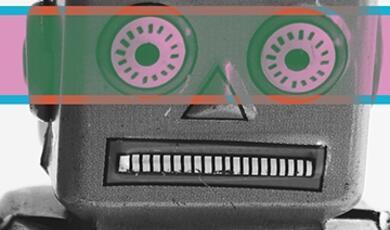Who’s Afraid of Robots?
Share
- Details
- Text
- Audio
- Downloads
- Extra Reading
Artificial Intelligence is a very recent invention…or is it? Humans have been fascinated by intelligent machines for thousands of years. Some exist only in our collective imagination, in art and literature. Others have seen the light of day as mechanical marvels, although a few were later exposed as elaborate frauds.
The robots of today might not be what our ancestors imagined. This lecture argues that the relationship between humans and machines has always been complex, and that we still can’t decide whether we really want them to be like us.
Download Text
Who’s Afraid of Robots?
Dr Victoria Baines, IT Livery Company Professor of IT
7th January 2025
When did robots first come to exist? It depends on whether you think they need to exist ‘in real life’ or in our collective imagination. We could answer by saying that the word ‘robot’ was first applied to machines in a 1920 play by Czech writer Karel Čapek, R.U.R., or ‘Rossum's Universal Robots’ (Rossumovi Univerzální Roboti). It also depends on how you define the word ‘robot.’ Are they self-moving automata, self-sustaining machines, or all forms of artificial life? Do they need to bear a visual or other likeness to humans? When we take a closer look at history, we find that they are not solely 21st century, or even 20th century preoccupations. Indeed, humans have been grappling with these questions for millennia, even if they haven’t always used the same words.
If conceive of robots as automata we can certainly go back as far as the Hellenistic era (3rd century BCE) for mechanical designs that made use of hydraulics and pneumatics to create self-moving machines. Tracing the idea of automata takes us back even further, to some of our earliest extant literature.
Robots in Ancient Myth
Homer’s Iliad and Odyssey contain striking descriptions of automata and other beings that are the products of artifice. The word αὐτόματος appears four times in the Iliad – once to describe King Menelaus of Sparta as acting of his own accord, but subsequently to describe items produced by Hephaestus (Vulcan in the Roman tradition), the Ancient Greek god of technology. These include self-moving golden tripods, self-activated bellows, and servants “made of gold, but just like real live girls” (Il.18.375f.). Homer tells us that “They had intelligence (noos) in their chests/minds (phrenes), and they had the power of speech within them, and physical strength, and they had learned from immortal gods how to do their work. They bustled along, supporting their master’s weight.”[1] We are not given any insight into the handmaidens’ mechanics, but it is clear that they have been made rather than born, wrought by the hand of a god who is also a blacksmith, and therefore fashioned by techne – engineered – as much as by divine magic. So, the idea that we could create artificial servants is far older than our adoption of a Czech word for slavery – robota.
Hephaestus creates several other automata for King Minos of Crete (he of the Minotaur and the labyrinth). These were arrows that never failed to hit their target, rather like modern guided missiles, a golden hunting dog, sometimes called Laelaps (‘Hurricane’), who always caught his quarry, and an ‘animated guardian’ (phylax empyschos, according to the 6th century BCE poet Simonides) known as Talos. Generations of movie-goers will recognise Talos as the bronze giant from Ray Harryhausen’s stop-motion production of Jason and the Argonauts. Simonides describes Talos as “made [to serve as] guardian of the island” of Crete, also as its “watcher.” The most extensive characterisation of Talos appears in by Apollonius Rhodius’ Argonautica, written in 3rd century BCE Alexandria:
And Talos, the man of bronze, as he broke off rocks from the hard cliff, stayed them from fastening hawsers to the shore, when they came to the roadstead of Dicte’s haven. He was of the stock of bronze, of the men sprung from ash-trees, the last left among the sons of the gods; and the son of Cronos gave him to Europa to be the warder of Crete and to stride round the island thrice a day with his feet of bronze. Now in all the rest of his body and limbs was he fashioned of bronze and invulnerable; but beneath the sinew by his ankle was a blood-red vein; and this, with its issues of life and death, was covered by a thin skin.
Talos is vanquished when he is bewitched by Medea:
So Talos, for all his frame of bronze, yielded the victory to the might of Medea the sorceress. And as he was heaving massy rocks to stay them from reaching the haven, he grazed his ankle on a pointed crag; and the ichor gushed forth like melted lead; and not long thereafter did he stand towering on the jutting cliff. But even as some huge pine, high up on the mountains, which woodmen have left half hewn through by their sharp axes when they returned from the forest—at first it shivers in the wind by night, then at last snaps at the stump and crashes down; so Talos for a while stood on his tireless feet, swaying to and fro, when at last, all strengthless, fell with a mighty thud.
It is an extraordinarily lifelike depiction of an oddly hybrid being. In this version of the story, Talos is not an entirely wrought machine but a superhuman hangover from a time before humans, a Bronze Age in which giants are born from trees. In an earlier version of the myth seen in vase paintings, Jason loosens a bolt on Talos’ ankle to drain his life essence (ichor): this is the demise we see in Harryhausen’s movie.
…and Ancient Reality
By the 4th century BCE, the Cretan city of Phaistos had adopted Talos as their guardian icon, issuing coinage depicting both him and possibly the super-hound Laelaps. While it may be stretching the comparison rather to view these beings as akin to the cybermen and cyberdogs of modern science fiction, people in Classical Antiquity were capable of and comfortable with imagining metal humans and wondrously augmented animals.
Fig.1 Crete, Phaistos. c350-300 BC. AE17. Winged Talos advancing right, hurling a stone with his right hand, holding another stone in his left hand / ΦAIC-TIΩN, hound walking right, sniffing the ground. Svoronos 74, SNG Cop 520, BMC 27-28.
Apollonius’ depiction of Talos’ downfall comes at a time and in a place of incredible invention. Hellenistic Alexandria was a global hub for learning and innovation, especially in hydraulics and pneumatics. These were not infrequently put to work in the name of entertainment and spectacle, the most famous of those that have come down to us being the Grand Procession held for Ptolemy II in the city’s stadium in 279/278 BCE. According to Callixeinus of Rhodes (as remembered by characters in Athenaeus’ 2nd century CE Learned Banquet), in addition to exotic animals and floats of costumed dancers, there were giant automated figures:
After these came a four-wheeled cart, twenty-one feet long and twelve feet wide, drawn by one hundred and eighty men; in this stood a statue of Dionysus, fifteen feet tall, pouring a libation from a gold goblet, and wearing a purple tunic extending to the feet, over which was a transparent saffron coat; but round his shoulders was thrown a purple mantle spangled with gold. In front of him lay a gold Laconian mixing bowl holding one hundred and fifty gallons… After these came four-wheeled cart twelve feet wide and drawn by sixty men, in which was seated an image of Nysa, twelve feet high; she had on a yellow tunic with gold spangles, and was wrapped in a Laconian shawl. Moreover, this image could rise up automatically without anyone putting his hands to it, and after pouring a libation of milk from a gold saucer it would sit down again.
Amazingly, we know something about an Alexandrian engineer who may have worked on these automata. Ctesibius was a mechanical genius active in the city at the time. Although his own writings are lost to us, his work is commemorated by Roman writers Vitruvius and Athenaeus, whose Learned Banquet (11.97) attributes to him the invention of a pneumatic drinking-horn incorporated into a statue of Ptolemy’ wife, Arsinoë. Philon of Byzantium’s (floruit 200 BCE) activity in Alexandria is a little late for Ptolemy’s Grand Procession but is believed to have built on the work of Ctesibius, as is that of Heron of Alexandria in the 1st century CE. Both Philon and Heron were known as Mechanichus – ‘The Mechanic.’ Heron even published a work entitled On Automata-making.
So, automata such as animated statues have served as objects of wonder (thaumata) for thousands of years, just as Vaucanson’s Flute Player, Tambourine Player, and Digesting Duck did in 18th century France and Maelzel’s Mechanical Turk on its global tour in the late 18th and early 19th centuries (more on which below). As has been observed by Adrienne Mayor in her excellent book Gods and Robots, to which my research for this lecture is heavily indebted, identification in an Ancient Indian legend of the robotic guards of Buddha’s relics as based on technology stolen from ‘Greek-speakers’ in ‘Rome’ perhaps suggests that there was specific knowledge transfer between the two cultures.[2]
In this legend, theft of the secrets of automata construction results in death at the hands of killer robots, and elsewhere in Ancient History we see evidence of the misuse of this technology. As wondrous as it may be, it is also to be feared. The most extreme example is the murderous ‘fembot’ modelled on Apega, the wife of the Spartan tyrant Nabis. The Hellenistic historian Polybius recounts (13.6f.):
He had also constructed a machine, if one can call such a thing a machine. It was in fact an image of a woman richly dressed and was a very good likeness of the wife of Nabis. Whenever he summoned any of the citizens before him with the design of extracting money from him he would begin by addressing him in kind terms, pointing out the danger to which the city and country were exposed from the Achaeans and calling attention to the number of the mercenaries he was obliged to maintain to ensure the safety of his subjects, as well as to the amount spent on religious ceremonies and the public outlay of the city. If they yielded to these arguments, it was sufficient for his purpose. But if anyone refused and objected to pay the sum imposed, he would continue somewhat as follows: "Very possibly I shall not be able to persuade you, but I think this Apega of mine may do so" — this being his wife's name — and even as he spoke in came the image I have described. When the man offered her his hand, he made the woman rise from her chair and taking her in his arms drew her gradually to his bosom. Both her arms and hands as well as her breasts were covered with iron nails concealed under her dress. So that when Nabis rested his hands on her back and then by means of certain springs drew his victim towards her and increasing the pressure brought him at all in contact with her breasts, he made the man thus embraced say anything and everything. Indeed by this means he killed a considerable number of those who denied him money.
Sadly – or fortunately – the Apegabot does not survive, and we have no other means of establishing whether it really existed. The episode is, however, presented as historical fact by a near contemporary of Nabis. Indeed, Polybius’ father had served with the Achaean Confederacy general Philopoemen, who had defeated Nabis in 200 BCE. The technology required to engineer a crushing and stabbing automaton is accepted as plausible. Today’s science fiction fans may be put in mind of numerous parallel depictions of the murderous fembot, not least among them the martial arts inspired techniques of Pris (as played by Daryl Hannah), the ‘basic pleasure model’ replicant in Blade Runner. The Apegabot is the ultimate perversion of the golden handmaidens of Hephaestus. But she is not the earliest evil, ‘made’ woman. She sits in a tradition that goes back to Pandora, who in the version of the myth told by the poet Hesiod was created as the cause of all man’s woes and to punish the human race (Works and Days 53-105). While the idea was Zeus’, the craftsmanship again belonged to Hephaestus.
Illusions of Automata
Such has been our desire for ‘thinking’ machines that we have constructed devices that have pretended to be sentient. The Automaton Chess Player aka The Mechanical Turk unveiled by Wolfgang von Kempelen in 1770 was presented as autonomous. The Turk toured the world with Kempelen and its subsequent owner Johann Nepomuk Mälzel, baffling and delighting audiences in equal measure, and defeating both Benjamin Franklin and Napoleon Bonaparte. As Edgar Allan Poe observed in an 1836 essay (see Further Reading), “we find everywhere men of mechanical genius, of great general acuteness, and discriminative understanding, who make no scruple in pronouncing the Automaton a pure machine, unconnected with human agency in its movements, and consequently, beyond all comparison, the most astonishing of the inventions of mankind.” Poe, however, was not convinced, stating, “It is quite certain that the operations of the Automaton are regulated by mind, and by nothing else. Indeed this matter is susceptible of a mathematical demonstration, a priori. The only question then is of the manner in which human agency is brought to bear.”
He was not alone in asserting that the Turk was an elaborate hoax. But the precise nature of the machine’s operations was not fully revealed until 1857, when S. W. Mitchell, the son of its final owner, published a mock obituary following its destruction in a museum fire.[3] A series of human operators, all highly skilled chess players, had been concealed in the cabinet beneath the Turk. While the machinery required to move the mannequin and to maintain the illusion was no mean feat of engineering – operators rolled out of sight when the owner opened doors that enabled viewers to see ‘through’ the cabinet – arguably the greatest achievement of all was the ability of respective owners and operators to keep this knowledge secret for several decades. Mitchell explains thus:
Perhaps no secret was ever kept as the Turk’s has been. Guessed at, in part, many times, no one of the several explanations in our possession has ever practically solved this amusing puzzle. For several years, the Turk was owned by a company of Philadelphia gentlemen. All of them were aware of the secret. It was, however, a self-guarded trust, since few who had seen the interior arrangements of the automaton, would have been able to expound his puzzling anatomy. Half in jest, then, and partly from the above-named consideration, the secret has been kept.
People wanted to believe what they saw, and its owners had a vested interest in ensuring that they did. Not only was their machine a profit-making venture, but they were also (says Mitchell) laughing at our expense. In the end, the Turk was the engineering equivalent of a conjurer’s smoke and mirrors. One wonders whether the secret of its operations would have been so closely guarded in our current era of social media, citizen news reporting, and viral (mis)information. At the same time, it is tempting to draw parallels between the Turk’s enchantment of its audience and more recent hype over Artificial Intelligence. Both technologies offer a semblance of sentience, such that even the most expert professionals reportedly find themselves willing to suspend their disbelief. In 2022, a Google engineer was dismissed from the company for claiming that its Language Model for Dialogue Applications (LaMDA) had a soul.[4]
Hype generates expectations which are rarely balanced. Technology provokes fear as often as it sparks wide-eyed enthusiasm, an unemotional reaction less so. As I have explored in detail elsewhere, the default rhetoric of technological progress is hyperbole.[5] At one extreme the ‘tech bro’ in-crowd evangelises sometimes to the point of over-promising. At the other, television/video games/screen time/social media/AI [delete as appropriate] are diagnosed as the downfall of humanity. Ambivalence is not an option.
Supercilious in-jokes don’t help to endear superior Big Tech minds to ‘ordinary’ people. When Amazon established a global marketplace for ‘microtasking’, the coordinated outsourcing of jobs to a distributed workforce, they called it Mechanical Turk. Unless one knows the story behind the operations of the Turk, the name may give the service an air of mystery, when in fact it is a very specific reference to the humans that make the illusion of automation possible, and are thus in the service of technology. In the context of both ongoing exploitation of lowly paid tech workforces around the world, and our own exploration of those of the past in my lecture on the Ancient History of Computers and Code, some of us may find such a light-hearted reference in poor taste.
Satirical Robots
That is not to say that there is no room for laughter in robot-human relations. If you watched my lecture on The Massive Internet of Things, you will know that I have an amusing co-dependent relationship with my robot vacuum cleaner, which has so far resulted in it ‘surprising’ me a number of times with seemingly spontaneous activity. I in turn thank it for its service and assist it over countless obstacles in my home. For a while, in the absence of a pet, child, or other companion, I found myself slipping into direct engagement with a machine, much as many of us do with smart speakers and virtual assistants. While this may make us feel temporarily foolish, I would argue that a natural inclination towards kind and humane interactions is cause for hope.
Ever since Talos and Apega, humanoids have served as mirrors for our behaviour towards each other, our foibles, and our preoccupations. This tradition persists in countless depictions in science fiction – among them Blade Runner’s replicants, the cute slapstick of Star Wars’ C3PO and R2D2, and inheritance of our saddest traits in Douglas Adams’ Marvin the Paranoid Android. It lives on also in the surviving art of automata making, including that of engineer and cartoonist Tim Hunkin, whose machines can be found on Southwold Pier in Suffolk and in the Novelty Automation arcade just a stone’s throw from Gresham College.[6] Among machines that simulate the experience of being frisked by security staff, a highly condensed ‘micro-break’ holiday, divorce, being probed by aliens, and the awkwardness of eye contact when travelling on the London Underground, are coin-operated humanoids that put a satirical spin on the laughing policemen and fortune tellers of yesteryear. An art expert modelled on former Tate Gallery director Nicholas Serota passes judgement on whether a submitted object is or is not art, rather snobbishly and uncouthly sticking out his tongue in the process. A lady chiropodist subjects the paying victim’s stockinged feet to examination and manipulation, and a doctor (GP) diagnoses ailments with a stethoscope, writing out prescriptions that are “totally illegible, like all real prescriptions.”
The effect – on me, at least – is to prompt one to re-consider the automatic, mechanical quality of many of our ostensibly human interactions, to question the extent to which they are meaningful, and to ponder our willingness to subject ourselves to them. Indeed, one of the most striking things about Hunkin’s automata is the nervous glee with which visitors to the arcades place themselves at the mercy of the machines. I squealed when the giant rubber gloves of the Autofrisk machine subjected me to a manual security search (the Alien Probe is even more intrusive), and I admit to having been slightly worried when the chiropodist disappeared from view to inspect my bunions. It would seem that context may be important here – humans are willing to interact with machines like this when they perceive themselves to be in a safe, controlled space. There’s something of a parallel with the use of digital technology in our homes, where the perception of safety in the domestic environment can lead us to be somewhat foolhardy with our security and privacy. There’s perhaps also another lesson for our developing interactions with Artificial Intelligence: with sufficient safety measures (currently known as ‘guardrails’) we may be persuaded to trust AI.
Robotic Roles Through Time
Historical and contemporary examples illustrate how artificial life has been conceived of as both serving and threatening man. The current concerns about AI ‘taking over’ echo centuries-old fears that increasing mechanisation/automation jeopardises lives and livelihoods – also that traditional master/slave relationships will be subverted. Indeed, Aristotle speculated on this precise dynamic in his 4th century BCE treatise on Politics (1253b):
And every assistant is as it were a tool that serves for several tools; for if every tool could perform its own work when ordered, or by seeing what to do in advance, like the statues of Daedalus in the story, or the tripods of Hephaestus which the poet says ‘enter self-moved the company divine,’ — if thus shuttles wove and quills played harps of themselves, master-craftsmen would have no need of assistants and masters no need of slaves.
Anthropomorphic machines are therefore the ultimate underclass, property that we don’t even need to dehumanise in order to comfortably exploit them. Curiously, we can’t dismiss them as ‘savages’ just as previous generations of humans explained away their mistreatment of colonised peoples. While not always sentient, the robots of our imagination and our reality are often characterised as highly sophisticated. But we can at least reassure ourselves that they do not have feelings to hurt, and that they do not have rights – at least, not yet.
There’s an inevitable tension here with the role of robots as companions to humans. In fiction, made sidekicks such as the Tin Man in The Wizard of Oz and Marvin the Paranoid Android in The Hitchhiker’s Guide to the Galaxy are enlivened but still very much subordinate to their human counterparts. In the latter, the Sirius Cybernetics Corporation’s definition of a robot as “Your Plastic Pal Who’s Fun to Be With” is challenged not only by Marvin’s depressive personality, but by the Guide itself in its definition of the marketing division of the Sirius Cybernetics Corporation as “a bunch of mindless jerks who’ll be the first against the wall when the revolution comes”.[7]
In the ‘real’ world, robot pets may attract our affection and engagement but can ultimately be switched off. This is not to deny the ability of humans to develop emotional attachments to machines, sometimes known as the Tamagotchi Effect after the virtual pets first popularised in the 1990s. As we saw in my lecture on Sex and the Internet last year, recent developments in both robotics and AI are powering a burgeoning market for advanced sex robots that can be customised according to the client’s preferences for physical appearance, anatomy, and personality. Like Pygmalion in the Greco-Roman myth as told by Ovid (Metamorphoses 10.243ff.), men (for the most part) are able to carve out an image of their ideal woman, which is then brought to life:
Pygmalion saw these women waste their lives in wretched shame, and critical of faults which nature had so deeply planted through their female hearts, he lived in preference, for many years unmarried.—But while he was single, with consummate skill, he carved a statue out of snow-white ivory, and gave to it exquisite beauty, which no woman of the world has ever equalled: she was so beautiful, he fell in love with his creation. It appeared in truth a perfect virgin with the grace of life, but in the expression of such modesty all motion was restrained—and so his art concealed his art. Pygmalion gazed, inflamed with love and admiration for the form, in semblance of a woman, he had carved.
Pygmalion’s animated statue is the perfect woman because she is unlike real women. Ideal women in virtual worlds and as sex/companion robots are often similarly fashioned with extreme ‘made to order’ features that are reminiscent of those prized in mainstream pornographic performance. AI-enabled apps marketed as ‘virtual boyfriends’ and ‘virtual girlfriends’ are similarly customisable. This does not of itself preclude emotional engagement. In a different context, use of AI to (re)create an interactive semblance of a deceased loved one is central to so-called ‘Grief tech’ apps. The jury is still out on whether these help or hinder the grieving process.
Modern Preoccupations Through an Ancient Lens
Experts are equally divided on whether machines can ever become sentient. If they do (and that’s a big ‘if’), will we need to treat them better than we do now? Kazuo Ishiguro’s 2021 novel Klara and the Sun imagines a speculative future from the point of view of an intelligent Artificial Friend (AF) to an academically gifted, sick child. Without wanting to spoil the plot for those who haven’t read it, Klara’s experience as a companion and potential human substitute prompts discomforting reflection as much about how we (should) treat each other as about how we (should) interact with technology. In that respect, Klara and other modern representations of androids and automata are the inheritors of Talos, the golden handmaidens of Hephaestus, and Pygmalion’s perfect girl.
When we factor in that Homer also described driverless vehicles, self-steering ships that “discern their course by their wits” (τιτυσκόμεναι φρεσί, Odyssey 8.556) and “of themselves understand the thoughts and minds of men” (ἴσασι νοήματα καὶ φρένας ἀνδρῶν, 8.559), we may be tempted to conclude that the Ancient World anticipated all our current preoccupations with automation. And yet we now find ourselves confronted with the notion of ‘bots’ that are not embodied androids so much as comprised of data. Our ancient ancestors could not, it seems, have foreseen that the harnessing of electricity would extend our understanding and therefore development of Artificial Intelligence beyond humanoid automata to algorithmic entities.
© Professor Victoria Baines 2025
[1] English translation by Kenneth Silverman in his article “The Androids of Hephaestus: Between Human and Machine in the Iliad.” https://www.researchgate.net/publication/359605817_The_Androids_of_Hephaestus_Between_Human_and_Machine_in_the_Iliad
[2] https://theconversation.com/robots-guarded-buddhas-relics-in-a-legend-of-ancient-india-110078#:~:text=Techno%2Dmarvels%2C%20such%20as%20flying,now%20Patna)%20in%20northeastern%20India.&text=Traditionally%2C%20statues%20of%20giant%20warriors,Buddha%27s%20relics%20throughout%20the%20realm.
[3] “The Last of a Veteran Chess Player”, Chess Monthly, January 1857 - https://babel.hathitrust.org/cgi/pt?id=hvd.hn43vw&seq=17
[4] https://www.npr.org/2022/06/16/1105552435/google-ai-sentient
[5] V. Baines. 2022. Rhetoric of InSecurity: The Language of Danger, Fear and Safety in National and International Contexts. Routledge.
[6] https://www.timhunkin.com/control/a_arcade_index.htm
[7] An assertion that is itself undermined by a footnote to the effect that the editors would welcome applications from anyone interested in taking over the post of robotics correspondent.
Further Reading and Resources
Andriana Domouzi & Silvio Bär (eds.). 2024. Artificial Intelligence in Greek and Roman Epic. Bloomsbury Academic.
Tim Hunkin. 2009. “The Uncanny Valley”. https://www.timhunkin.com/a158_uncanny-valley.htm
Laura Lawton. 2017. “Taken by the Tamagotchi”. The i Journal 2.2. https://theijournal.ca/index.php/ijournal/article/download/28127/20721
Adrienne Mayor. 2018. Gods and Robots: myths, machines, and ancient dreams of technology. Princeton University Press.
Gemma Milne. 2020. Smoke & Mirrors: How hype obscures the future and how to see past it. Hachette.
Masahiro Mori. 1970. “The Uncanny Valley”, trans. K. F. MacDorman & Norri Kageki. https://web.ics.purdue.edu/~drkelly/MoriTheUncannyValley1970.pdf
Edgar Allan Poe. 1836. “Maelzel’s Chess-Player”. Southern Literary Messenger. April 1836:2:318-326. https://www.eapoe.org/works/essays/maelzel.htm
E. R. Truitt. 2015. Medieval Robots: mechanism, magic, nature, and art. University of Pennsylvania Press. Robinson.
© Professor Victoria Baines 2025
Andriana Domouzi & Silvio Bär (eds.). 2024. Artificial Intelligence in Greek and Roman Epic. Bloomsbury Academic.
Tim Hunkin. 2009. “The Uncanny Valley”. https://www.timhunkin.com/a158_uncanny-valley.htm
Laura Lawton. 2017. “Taken by the Tamagotchi”. The i Journal 2.2. https://theijournal.ca/index.php/ijournal/article/download/28127/20721
Adrienne Mayor. 2018. Gods and Robots: myths, machines, and ancient dreams of technology. Princeton University Press.
Gemma Milne. 2020. Smoke & Mirrors: How hype obscures the future and how to see past it. Hachette.
Masahiro Mori. 1970. “The Uncanny Valley”, trans. K. F. MacDorman & Norri Kageki. https://web.ics.purdue.edu/~drkelly/MoriTheUncannyValley1970.pdf
Edgar Allan Poe. 1836. “Maelzel’s Chess-Player”. Southern Literary Messenger. April 1836:2:318-326. https://www.eapoe.org/works/essays/maelzel.htm
E. R. Truitt. 2015. Medieval Robots: mechanism, magic, nature, and art. University of Pennsylvania Press. Robinson.
© Professor Victoria Baines 2025
Part of:
This event was on Tue, 07 Jan 2025
Support Gresham
Gresham College has offered an outstanding education to the public free of charge for over 400 years. Today, Gresham College plays an important role in fostering a love of learning and a greater understanding of ourselves and the world around us. Your donation will help to widen our reach and to broaden our audience, allowing more people to benefit from a high-quality education from some of the brightest minds.


 Login
Login







